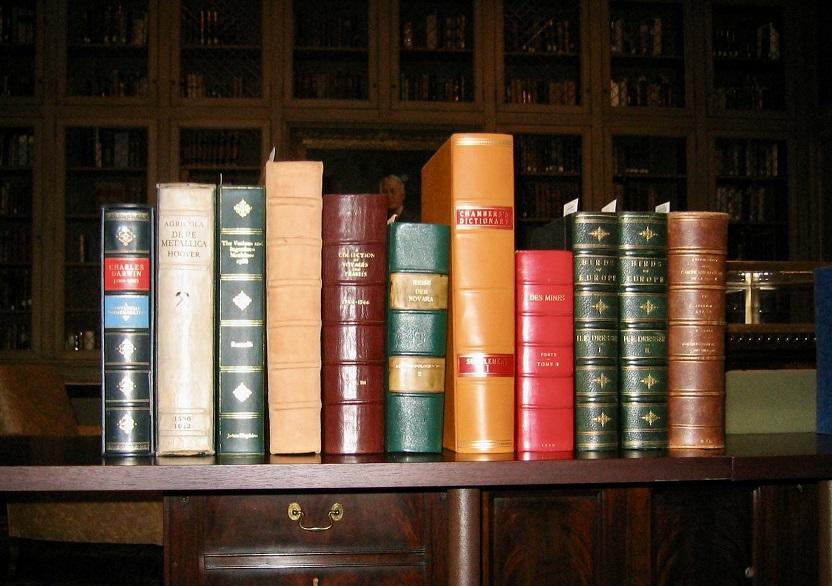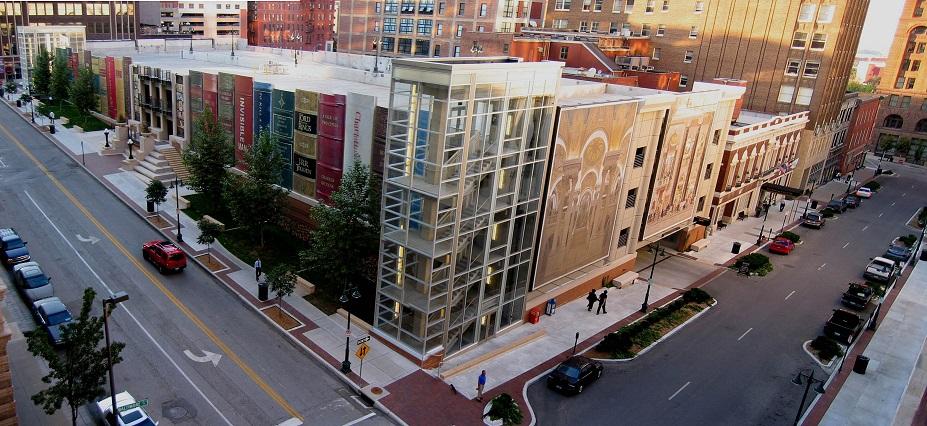Here’s The Story Behind the Kansas City Public Library’s Giant Community Bookshelf

KC Studio published this article in its May/June edition.
The Kansas City Public Library opened its new downtown headquarters at 14 W. 10th Street in April 2004. After significant updates and renovation, the historic First National Bank, now the Central Library, retains imposing features, such as marble, bronze doors and windows, and chandeliers.
Even if you’ve never stepped inside the 1906 building – it’s likely you’re familiar with the four-story parking garage. On the south façade, there’s a collection of 26-foot-tall and nine-foot-wide books – the Community Bookshelf.
“If you type in the ‘10 weirdest buildings’ in Google, it pops up,” says Jonathan Kemper, chairman emeritus of Commerce Bank, Kansas City Region.
Twenty-two book spines feature 42 titles fromTo Kill a Mockingbird to Charlotte’s Web, as well as books with Kansas City ties such as Evan S. Connell’s Mrs. Bridge and Buck O’Neil’s autobiography, I was Right on Time.
“The Library is, in many ways, an ambassador for the community,” says Kemper, who joined the board of trustees in 2001 and served 17 years as its president, “and one which shows that Kansas City has a fun side."
Architecture firm BNIM and 360 Architecture (now HOK) created the design for the 480-car garage. Kemper remembers asking, “‘Does it have to be ugly?’ and ‘What are we going to do to make it part of the neighborhood?’”
For Kemper, it was important that the garage not only be “efficient and cost-effective” but also “interesting and beautiful.” The design called for precast concrete columns and he suggested attaching something to them – such as books.
Dimensional Innovations, an industrial design company in Overland Park, Kansas, had worked with Kemper before – restoring Commerce Bank’s lobby to its original condition, rebuilding a chandelier and recreating marble. So DI was invited to a meeting.
“I think J.E. Dunn (the general contractor) identified us as problem solvers,” says owner and CEO Tucker Trotter, who recalled “about 50 people” in a session suggesting ideas, such as glass windows and abstracted books.
“And I said (to Kemper), ‘Well, what do you want?’ And he said, ‘I want giant books.’” And Trotter remembers he said, “Yes, we can do this.”
But how to achieve this required lots of trial and error. Trotter immediately tapped J.C. Hendricks, vice president and executive creative director of Interactive Technology, and they gathered a team and got to work.
Trotter took a digital photo of an old book at his grandfather’s house. They printed it and wrapped it around a pre-cast mockup panel – and everything started to fall into place.

A visit to the Linda Hall Library, the independent research library, required “a full day of looking at old books,” says Hendricks. A paper foam core model based on rare books in the collection allowed them to manipulate each book’s placement.
But what books to include? The selection process, of course, started with librarians. The board of trustees also tapped independent bookstore Rainy Day Books for a list of suggested titles. And, in December 2003, the Library sought input from the public.
“Help the Library add books to the garage bookshelf!” read the headline on the Library’s website. The call for suggestions stated that it was “not a contest but rather an opportunity to become part of the revitalization of downtown Kansas City.”
There were requirements: a Kansas City connection and titles considered classics; a range of genres, such as science fiction, history, mysteries, or biographies; and a reflection of diversity.
“I really liked the idea of the Library stepping out and saying: ‘Here’s what we consider to be a possible community bookshelf,’” Kemper says. “These are not the ones you have to read. But these are to inspire you. So that was the idea.”
Area residents sent in about 100 book titles; these were mailed, faxed, and emailed. An Independence, Missouri, woman sent a letter in flowing cursive script listing 20 books and when she read each of them, starting at age 5.
By mid-March 2004, the board of trustees had selected titles for the bookshelf, including Rachel Carson’s Silent Spring and Lao Tzu’s Tao Te Ching. To incorporate more works, there are anthologies: one of children’s stories and two of Kansas City stories.
Twenty-two oversized book bindings printed on 3M Scotchprint wrap the aluminum substructure on the exterior of the garage.

Over the last two decades, the Library’s Community Bookshelf has racked up accolades, such as Best Structure Award from the Precast/Prestressed Concrete institute and Best of Show from the International Sign Contest.
The parking garage has also cropped up in a National Building Museum exhibition in Washington, D.C. A Popular Mechanics article titled “The World’s 18 Strangest Buildings and Why We Love Them” described how the garage “uses huge, unrealistic objects to catch the eye.”
And it still does.
Trotter says the project put Dimensional Innovations, founded in 1993 as a sign company, on a new trajectory. “We feel real ownership,” he says. “It was like a signature project for us, a defining project.”
“The idea of building meaning or depth, that’s the nicest thing about it,” says Kemper. “You took a garage which was meant to be a necessity and made it more than that.”

